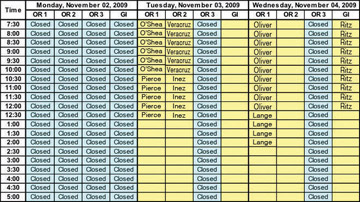Two words that strike fear in the heart of every OR manager: open time. That, of course, is when your ORs sit silent and empty while it's standing-room only in the staff lounge. More often than not, open time stems from inefficient scheduling. Here's how to correct that.
1Collect the data. You'll want to use data to schedule more effectively, but you can only do that when your staff fully uses your facility's software. Your case history modules should tell you everything you need to know about each case: from time in/out of the room to anesthesia start/stop time to time of incision. These reports should point you to the weak links in your scheduling. Train your staff to input the data.
2Set a block-time threshold. Block time is a privilege, not a right. If your physicians aren't using the blocks you've given them, you're going to have empty ORs and idle staff. A good rule of thumb: If you're turning doctors away because you can't fit them on your schedule, but you've still got holes in your schedule because of unused block time, you've got a problem. The best solution is a set-in-stone percentage of block time that physicians must fill. Let's say you set the block time utilization threshold at 70% of their scheduled time. If doctors are only filling their schedules, say, 50% of the time, you should cut the blocks accordingly.
3Create a ramp-up schedule. When bringing on new surgeons, you'll want to analyze anticipated case volume. Create a form for potential physicians that asks how many cases they typically do by day or by block, how many of those cases they'd bring to your facility and what the case mix is likely to be (for example, will an orthopod's cases include complicated shoulder surgeries or simple knee arthroscopies?). You'll also want to get the physician's payer mix. You might think twice if 17 of the 20 cases an ENT wants to bring to your facility each month are Medicaid patients.
.svg?sfvrsn=be606e78_3)

.svg?sfvrsn=56b2f850_5)